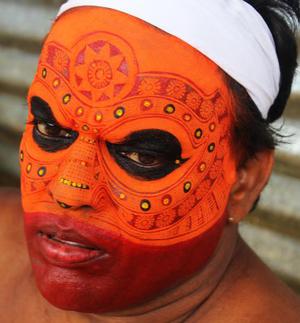 The conceptualisation of a new Theyyam, Alanthatta Daivathareeswaran, in Kasaragod, was a special event that was a confluence of tradition, folk lore, belief and rituals
The conceptualisation of a new Theyyam, Alanthatta Daivathareeswaran, in Kasaragod, was a special event that was a confluence of tradition, folk lore, belief and rituals
Bara is a pretty village near Kasaragod, a few kilometres from the national highway. A Daivathar temple at Alanthatta in Bara is filled with devotees by 8 am. People from far-off places have assembled there to witness the premiere of a new Theyyam.
Such occasions are rare and there are several ritualitic procedures linked to it. It is not clear when Theyyams evolved into a form of worship that elevates idols to the dynamism of moving manifestations. The belief is that it originated in the fertility cult of an agrarian society, which gradually became stylised. There are scholars who opine that the Theyyam is related to the cult of hero worship as it existed in the Sangam period (300 BC- 250 AD).
Contemporary Theyyam concepts go back to the legendary Manakkatan gurukkal of about four centuries ago. He rose to a challenge by showcasing 39 Theyyams before the then Chirakkal Tampuran, king of the erstwhile Kolathiri dynasty in Kannur. Of these, the Tampuran selected 35 for consecration. These are considered as the base from which more Theyyams originated — surrealistic expressions linked with the worship of gods, heroes, ancestors, warriors, enemies killed in fight, tragic characters and animals, among others. There are nearly 450 such identifiable Theyyams, of which about 50 are usually performed. The origins of almost all these Theyyams are based on some incidents or omens and popular faith irrespective of religion, and authenticated by astrological predictions and royal sanction.
At Alanthatta, a divine spirit called Daivathar has been worshipped from time immemorial in the form of an image resembling a mirror, which was carved on a stone. It was renovated as a temple in 2013. During the thottam (rustic songs explaining the origin of the Theyyam concerned, the locality, history and so on that is sung as a prelude) of the Theyyams, the Alanthatta Daivathar is customarily praised.
“However, at present, nobody knows about a Theyyam by the name of Alanthatta Daivathar. Astrological deliberations at the temple, prior to its renovation, pointed out the necessity of conducting a Theyyam by the name Alanthatta Daivathareeswaran here,” explains Balakrishnan Nair, secretary of a committee constituted to conduct the deification and triennial Theyyam festival.
A Theyyam by the name of Daivathar does exist but the one that was premiered at Alanthatta is different as it exalts Lord Rama as an ascetic on the banks of Sarayu river. The predominant right to perform Theyyams in the region belongs to members of Malaya and Koppala communities living in the area. However, astrological beliefs mandated that in this temple, only a member of the Vannan community should perform at the temple. Finally, Dineshan Peruvannan, a seasoned Theyyam exponent from Azhikode, Kannur, was chosen to decide the ritual, attire and performance of the Alanthatta Daivathareeswaran.
Taking into consideration the demands of the concept of the Alanthatta Daivathareeswaran (Theyyam), the choreography was designed without any vibrant movements or dance unlike many other Theyyams to symbolise the mood of detachment and renunciation.
“Suitable verses in praise of the local deities were adapted from various slokas and the Narayana paadam thottam of other Daivathars were also incorporated for the thottam of the new Theyyam,” says Dineshan.
To maintain the stayi (dominant mood) of the Theyyam, the Daivathareeswaran is not supposed to speak unlike other Theyyams. Blessings are only by giving flowers chethippoovu (Ixora) and thulasi (basil) used in temple rituals. The devotees are allowed to hold on to the bow and arrow of the Theyyam while seeking blessings.
“It is a rare privilege to do this Theyyam and is challenging as the dominant mood is that of a Yogi, unlike usual Theyyams,” muses Kanoor Kumaran Vannan, who donned the role.
– Extract from the Friday Review
25 May 2018
